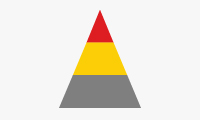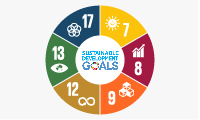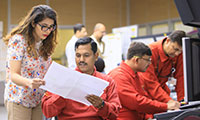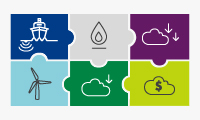Flaring
The flaring of natural gas wastes valuable resources and contributes to climate change. We are working hard to reduce flaring associated with oil and gas production.
When oil is extracted from a reservoir, gas is also produced as the oil is brought to the surface. This is known as associated gas. This gas can be captured and used alongside the oil. When there are no facilities to gather the gas, or they have insufficient capacity, it is sometimes flared, or burned off. Flaring is also carried out for safety reasons to relieve pressure in the production system.
Shell’s policy is to reduce any routine flaring or venting of associated gas at our operations to a level as low as technically and economically feasible. We also aim to minimise operational flaring required for safety reasons such as during the start-up of a new facility. Our flaring policy is set out in our Health, Safety, Security, Environment and Social Performance (HSSE&SP) Control Framework. It includes the requirement that all facilities must be designed to export, use or reinject associated gas and that all facilities have to meet strict performance criteria.
Shell has been an active member of the World Bank-sponsored Global Gas Flaring Reduction partnership since 2002. This public-private partnership helps reduce flaring by working collaboratively to find alternative uses for gas that would otherwise be flared. As part of the partnership, the World Bank has developed the Zero Routine Flaring by 2030 initiative, which Shell signed in 2015. This encourages governments, companies and development organisations to work together to end flaring. The initiative aims to identify ways to use gas from oil production – for example, to generate electricity for local communities.
Our performance
Flaring of gas in our Upstream and Integrated Gas businesses contributed around 11% of our overall direct GHG emissions in 2017. Almost half of this flaring took place at facilities where there was no infrastructure to capture the associated gas.
Close to 80% of flaring from Shell-operated assets in 2017 occurred in Iraq, Nigeria, Malaysia and Qatar. Our flaring increased by slightly less than 10% from 7.6 million tonnes in 2016 to 8.2 million tonnes in 2017. This was primarily a result of increased production in Nigeria following the return to production of fields previously closed due to security issues. Work continues to bring additional gas gathering facilities online in Nigeria to reach our goal of no routine flaring by 2030.
In Iraq, the Majnoon facilities (Shell interest 45%) captured about 44% of associated gas that otherwise would have been flared in 2017. The gas was exported to a local power plant for electricity generation.
Basrah Gas Company (BGC, Shell interest 44%) is a non-operated joint venture with Iraq’s South Gas Company and Japan’s Mitsubishi. It captures gas that would otherwise be flared from three non-Shell-operated oil fields in southern Iraq (Rumaila, West Qurna 1 and Zubair) for use in the domestic market. In 2017, BGC processed an average of 676 million standard cubic feet of gas each day from these fields to produce electricity.
These projects are helping to improve the power infrastructure of the country and deliver much-needed energy to the population. They involve collaboration with the Iraqi government, joint-venture partners, domestic companies and non-governmental organisations.
Nigeria
In Nigeria, flaring from Shell Petroleum Development Company’s (SPDC) joint-venture (Shell interest 30%) facilities fell by close to 90% between the start of the programme in 2002 and 2017. This reduction was mainly due to investing in associated gas gathering and processing facilities that capture the associated gas and commercialise it for either the domestic or export market. Divestments also resulted in a further reduction. However, flaring intensity levels from SPDC JV facilities increased in 2017, mainly due to the restart of facilities that were off-line in 2016.
SPDC supports the elimination of routine flaring as quickly as practical. However, to do so requires significant investment in gas-gathering and processing facilities or the stoppage of associated oil production which generates revenue for the Nigerian economy. Several new gas-gathering projects came on stream at the end of 2017 however, the planned start-up dates for two gas-gathering projects have historically been delayed due to a lack of adequate joint-venture funding. Nevertheless, with funding now restored the projects are planned for completion in 2018-19.
Malaysia
In Malaysia, associated gas flaring at the Gumusut (Shell interest 29%) and Kikeh fields was eliminated by introducing a system in 2016 that injects gas back into the hydrocarbon reservoir. In 2017, the system worked as expected and production from the oil field was maximised.
Qatar
In Qatar, at our Pearl gas-to-liquids plant (Shell interest 100%), flaring takes place for operational reasons. In 2017, further enhancements to the plant were made to reuse more waste gas. (See Natural gas).
Flaring – upstream
million tonnes CO2 equivalent [A]
Enlarge image[A] includes Upstream and Integrated Gas
 Sustainability at Shell
Sustainability at Shell
 Sustainable development goals
Sustainable development goals
 About our data
About our data
 Energy transition and climate change
Energy transition and climate change